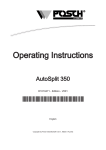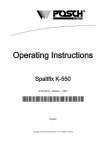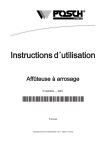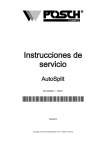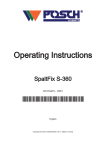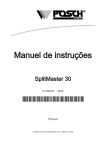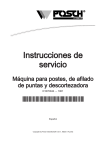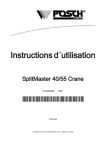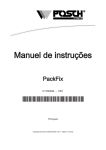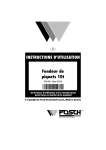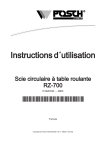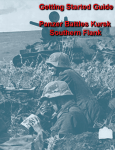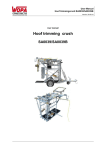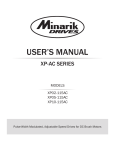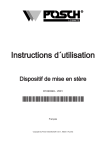Download HackBlitz 500
Transcript
Operating Instructions HackBlitz 500 D1010210 - V001 *D1010210-V001* English Copyright by Posch Gesellschaft m.b.H., Made in Austria Manufacturer Manufacturer POSCH Gesellschaft m.b.H. Paul-Anton-Keller-Strasse 40 A-8430 Leibnitz Tel.: +43 (0) 3452/82954 Fax: +43 (0) 3452/82954-53 E-mail: [email protected] http://www.posch.com © Copyright by POSCH Gesellschaft m.b.H., Made in Austria Please be sure to fill this in before starting. Then you can be sure that this document relates to your machine, so if you have any queries you will be given the correct information. Machine number:.............................................................................. Serial number:..................................................................................... POSCH Austria: 8430 Leibnitz, Paul-Anton-Keller-Strasse 40, telephone: +43 (0) 3452/82954, fax: +43 (0) 3452/82954-53, e-mail: [email protected] POSCH Germany: 84149 Velden/Vils, Preysingallee 19, telephone: +49 (0) 8742/2081, fax: +49 (0) 8742/2083, e-mail: [email protected] 2 Contents Contents 1 Foreword 5 1.1 Copyright notice 5 1.2 Liability for defects 5 1.3 Reservations 5 1.4 Definitions 5 1.5 Operating instructions 6 2 Safety information 7 2.1 Explanation of symbols 7 2.2 General safety information 7 2.3 Safety information for chopper 8 2.4 Noise 8 2.5 Remaining risks 9 2.6 Proper use 9 2.7 Incorrect use 9 3 General 10 3.1 Scope 10 3.2 Description 10 3.3 Major machine components 11 3.4 Stickers and their meaning 12 3.5 Set-up 13 4 Start-up 14 4.1 Switching position 14 4.2 Driven by tractor via universal joint shaft (type PZG) 14 5 Operation 16 5.1 Extractor pipe 16 5.2 Chopping procedure 16 6 Switching off the machine 18 7 Transport 19 7.1 Transport position - Extractor pipe 19 7.2 Transporting by three-point linkage on the tractor 19 7.3 Lifting with a crane 20 8 Checks 21 8.1 Protective guards 21 8.2 Screw fittings 21 8.3 Chopping blade and counter-cutter 21 3 Contents 4 8.4 V-belt tension 22 8.5 Oil level 22 9 Maintenance 23 9.1 Lubrication 23 9.2 Sharpen chopping blade 24 9.3 Setting the counter-cutter 25 9.4 Changing the V-belt 25 9.5 Oil changing 27 9.6 Cleaning 29 10 Troubleshooting 30 11 Technical data 31 12 Service 32 EC Declaration of Conformity 33 Foreword 1 Foreword Thank you for buying our product. This machine has been built in conformity with applicable European standards and regulations. These operating instructions explain how to operate the machine safely and efficiently and how to maintain it. Any person entrusted with the transport, installation, commissioning, operation or maintenance of the machine must have read and understood: ▪ the operating instructions ▪ the safety instructions ▪ the safety information given in the individual chapters. To avoid operator error and ensure problem-free operation, the operating instructions must be available to the operating personnel at all times. 1.1 Copyright notice All documents are protected by the law of copyright. Documents including excerpts thereof may not be distributed or reproduced nor may their content be communicated without express permission. 1.2 Liability for defects Read these operating instructions through carefully before putting the machine into operation. We accept no liability for damage or disruptions caused by failure to observe the operating instructions. Claims for liability must be reported as soon as the defect is identified. Claims are null and void for example in the following cases: ▪ improper use ▪ faulty attachments and drives not supplied with the machine ▪ failure to use original spare parts and accessories ▪ conversions or modifications, where not agreed with us in writing We are not liable for defects of wearing parts. 1.3 Reservations Technical data, dimensions, illustrations of the machine and safety standards are subject to continual change and are therefore not in any circumstances binding in relation to the supplied machine. We accept no liability for printing and typesetting errors. 1.4 Definitions Operator The operator is the party which operates the machine and uses it for its intended purpose or causes it to be operated by suitable, trained personnel. Operating personnel 5 Foreword The operating personnel (operators) are those entrusted by the operator to operate the machine. Technical personnel Technical personnel are persons entrusted by the operator of the machine with special tasks such as installation, set-up, maintenance and troubleshooting. Electrician An electrician is a person who, by virtue of his specialist training, has knowledge of electrical systems, standards and regulations and is able to identify and prevent possible hazards. Machine The term machine replaces the commercial designation of the object to which these operating instructions relate (see cover sheet). 1.5 Operating instructions This manual is a "translation of the original operating manual" 6 Safety information 2 Safety information 2.1 Explanation of symbols The following symbols and instructions in this manual provide warnings about possible personal injury or property damage or give useful information about working with the machine. DANGER Warning about danger zones Instruction regarding safe working, where non-compliance entails the risk of serious or fatal injury. Always observe these instructions and ensure that you work with particular caution and care. DANGER Crushing hazard Risk of injury through upper limbs getting trapped. NOTICE Instruction Symbol for proper use of the machine. Non-observance can result in malfunctions by or damage to the machine. Noise Symbol for an area where noise levels can exceed 85 dB(A). Non-observance can cause hearing problems or deafness. Further information Symbol for further information relating to a bought-in part. Information Action-related information. 2.2 General safety information The machine may only be operated by persons who are familiar with the machine’s operation and hazards and with the user manual. ▪ It is the operator’s responsibility to provide appropriate staff training. Persons under the influence of alcohol, drugs or pharmaceutical products that impair responsiveness must not operate or maintain the machine. 7 Safety information The machine may only be operated if it is in perfect working condition. Only operate the machine if it is in a stable position. Minimum age of operative: 18 years. Only one person may operate the machine at a time. Take regular breaks to ensure concentration. Ensure that your workplace is adequately illuminated since poor lighting can significantly increase the risk of injury. Never work without the protective guards in place. Only carry out repair, setup, maintenance and cleaning work when the drive is switched off and the tool is stationary. ▪ If the machine has a PTO drive, the universal joint shaft must be removed from the tractor. Never leave the machine running unattended. Switch off the machine's drive unit before carrying out any adjustments. Only use original - POSCH - spare parts. Do not modify or tamper with the machine. 2.3 Safety information for chopper Keep clear of the danger zone. Shredded material may be ejected across the entire zone. Wear goggles or a face mask while working. Never put your hand into the hopper or the extractor chute while the machine is running. If twigs or branches are causing an obstruction, remove them using a suitable implement (e.g. another branch). Shut the drive down before removing any jammed pieces of wood. Only use the machine outdoors. When turning off the machine, always be careful of the tool runout until the machine has come to a standstill. The working pressure of the hydraulic system must not exceed 160 bar. 2.4 Noise The workplace-related, A-rated emission sound pressure level is 95 dB(A), measured at the operative's ear. In the case of machines with a PTO drive, the noise level depends on the noise of the tractor. Ear protection is therefore necessary. The stated values are emissions values, and thus do not necessarily represent reliable values for the work area. Although there is a correlation between emission and pollutant levels, it is not possible to deduce reliably from that whether or not additional precautionary measures are necessary. Factors that influence the level of pollutants present in the work area include the individual nature of the work area, other sources of noise, e.g. the number of machines and other work operations being carried out in the vicinity. Equally, permissible values for a work area may vary between different countries. However, this information should enable the user to estimate the dangers and risks more accurately. 8 Safety information 2.5 Remaining risks Even if all safety precautions are observed and the machine is used in accordance with the instructions, some risks still remain: ▪ Touching of revolving parts or tools. ▪ Injury caused by flying logs or log pieces. ▪ Risk of burns if the engine is not properly ventilated. ▪ Hearing loss if ear protection is not worn when working. ▪ Human error (e.g. due to excessive physical exertion, mental strain, etc.) With every machine, some risks still remain. Therefore you should always be very careful when working. It is up to the operating personnel to ensure that work is carried out safely. 2.6 Proper use The machine - HackBlitz 500 - is designed exclusively for shredding the following material: ▪ Woody material such as brush, shrubs, bark, branches (up to a branch thickness of 10 cm). On no account must the following be allowed to get into the machine: ▪ Metal parts, stones, plastic twine, plastic sheets, glass, etc. ▪ Garden waste such as leaves, wilted flowers, etc. 2.7 Incorrect use Any incorrect use or use other than that specified under "Proper use" is expressly forbidden. 9 General 3 General 3.1 Scope This user manual applies to the following machines: Machine type Article no. * M4605 Designation - Type HackBlitz 500 - Z-W-D Drive PTO *.....The item number is stamped on the machine's rating plate. Models Special equipment .....M Flow divider (speed regulation for feed) 3.2 Description The machine - HackBlitz 500 - is designed for shredding wood waste and left-over products to a diameter of 10 cm . The machine is driven by a PTO shaft. The material is drawn in through the hopper with the aid of a hydraulically-driven feed roller. It is then shredded by the chopping blades at the adjustable counter-cutter and ejected via the rotatable extractor chute. The incline of the deflector can be varied. The shredded material is used as starter material for composting, as heating material for wood-chip heating systems and as covering material under newly-planted trees and shrubs. 10 General 3.3 Major machine components 1 2 3 19 4 18 5 6 7 17 8 16 9 15 10 14 11 13 12 1 2 3 4 5 6 7 8 9 10 Extractor pipe Deflector Adjuster chain Tensioning lever Control valve Tool box Oil motor Lifting eye Three-point linkage connection Cardan shaft support 11 12 13 14 15 16 17 18 19 PTO V-belt guard Frame Rating plate Lubrication point Swivel handle Switch bracket Feed roller Hopper 11 General Z2001164 3.4 Stickers and their meaning 2 1 8 7 3 6 4 5 2 3 4 5 6 7 8 Only carry out repair, set-up, maintenance and cleaning work when the drive is switched off and the tool is stationary. Caution, tool runs on Do not reach into the extractor chute! Wear protective gloves Wear safety shoes Wear goggles and ear defenders Danger from pieces being ejected, keep well clear of danger zone. Always read the user manual before operating the machine Danger zone PTO speed Noise level Rotational direction of PTO Z2001220 Oil level Z2001360 Lubrication point Z2050400 Hydraulic oil Z205 0561 Maximum branch diameter max. ø 10 cm Z205 0790 12 General Stickers on controls Feed (forwards / backwards) Z205 0871 3.5 Set-up Ensure the machine is stable before starting it. Set up the machine on a level, firm and clear work surface. The machine must be placed directly on the ground. Do not place wooden boards, flat pieces of metal etc. underneath it. 3.5.1 Danger zone Shredded material may be ejected across the entire zone. People must not stand in the danger zone. The machine must be set up in such a way that the danger zone is clearly visible, and that there are no animals, delicate objects or plants within it. 13 Start-up 4 Start-up Before starting to operate the machine, please check that the protective and safety systems are working and also the hydraulic hoses and oil level. If a fault occurs during operation, the machine must be shut down immediately. 4.1 Switching position The feed must be switched off before commissioning. 1 2 1 Hopper 2 Switch bracket ▪ Move the switch bracket to the 0 position. 4.2 Driven by tractor via universal joint shaft (type PZG) ▪ Assemble the machine on the three-point linkage of the tractor. ▪ Attach the universal joint shaft and secure with the safety chain. ▪ Clockwise rotation of the tractor PTO shaft. ▪ Turn the tractor's manual throttle to minimum. ▪ Slowly engage the tractor PTO shaft and allow the machine to start moving. ▪ Set the required PTO shaft speed using the manual throttle. Maximum PTO shaft speed: ▪ 540 rpm The maximum PTO shaft speed must on no account be exceeded, otherwise the oil will become too hot. This leads to premature wear and leaks in the pump, cylinder and hydraulic pipes. Before disengaging the universal joint shaft, set the manual throttle of the tractor to minimum. The universal joint shaft must be stored in the universal joint shaft linkage when it is disconnected. 14 Start-up A universal joint shaft with friction clutch (ratchet clutch) must be used. Recommended universal joint shaft: Item no. Z2000660 Max. torque 900 Nm Manufacturer Walterscheid 15 Operation 5 Operation At outdoor temperatures below 0°C, let the machine idle for approximately five minutes to allow the hydraulic system to reach the correct operating temperature (the hydraulic pipes will then be warm to the touch). 5.1 Extractor pipe 2 4 5 3 1 1 2 3 Spring bolt Extractor pipe Swivel handle 4 5 Deflector Adjuster chain Working position: ▪ Unlock the spring bolt and turn the extractor pipe into the required position using the swivel handle. ▪ Secure the extractor pipe with the spring bolt again. ▪ Set the incline of the extractor chute as required using the adjuster chain. Transport position: ▪ Unlock the spring bolt and turn the extractor pipe in the direction of the hopper. ▪ Secure the extractor pipe with the spring bolt again. 5.2 Chopping procedure Never put your hand into the hopper or the extractor chute while the machine is running. If twigs or branches are causing an obstruction, remove them using a suitable implement (e.g. another branch). The branch diameter must not exceed 10 cm. 16 Operation 1 2 1 Hopper 2 Switch bracket Switch bracket position: Position 0 1 2 Function Default position, no movement of the feed roller Chopping material is fed into the machine The chopping material is fed out of the machine ▪ Move the switch bracket to position 1. ▪ Push the chopping material into the hopper. ▪ Immediately let go of the chopping material as soon as it is gripped by the feed roller. – The chopping material is now fed to the chopping disc continuously. In the event of a jam, move the switch bracket to position 2, so that the chopping material is fed out of the machine. If the chopping material does not come out, the switch bracket must be moved to position 0 and the machine must be switched off. 2 1 1 Tensioning lever 2 Hopper ▪ Using the tensioning lever, release the load on the feed roller and remove the chopping material. Prior to switching off: ▪ When work is complete, load the machine with dry material. This will allow the machine to clean itself. After this, the machine should be allowed to idle for a short period, so that all of the chopping material is removed and no jams occur when it is started up again. 17 Switching off the machine 6 Switching off the machine Before switching off the machine, depressurise all hydraulic functions by placing all control levers in the neutral position. Driven by tractor via cardan shaft (type PZG) Disengage the cardan shaft on the tractor. ▪ Before disengaging, turn the manual throttle to minimum. 18 Transport 7 Transport It is vital that the drive is stopped before transport. Disengage the universal joint shaft on the tractor. ▪ Before disengaging, turn the manual throttle to minimum. 7.1 Transport position - Extractor pipe ▪ See ..... Extractor pipe [➙ 16] 7.2 Transporting by three-point linkage on the tractor ▪ Attach the machine to the three-point linkage and use the tractor hydraulics to raise it. If the tractor's rear lights are obscured, a light must be fitted to the rear of the machine (e.g. magnetic holder, clip-on light, etc.) Due to the weight of the machine, the tractor-machine combination can become unstable. In order to test the overall stability, the following formula can be used to calculate the minimum weight on the front side IF,min with a minimum front axle load of 20% of the empty weight of the tractor: I F,min = (I R x ( c + d )) - ( TF x b ) +( 0,2 x TE x b ) a + b TE IF TF TR IR TE (kg) Empty weight of the tractor * TF (kg) Front axle load of the empty tractor * TR (kg) Rear axle load of the empty tractor * IR (kg) Total weight of the machine ** IF (kg) Total weight of the front load a (m) b c (m) (m) d (m) Distance between front load's centre of gravity and centre of the front axle Wheelbase of the tractor Distance between centre of the rear axle and centre of the lower link balls Distance between centre of the lower link balls and the machine's centre of gravity *** *** *** *** *….. see tractor operating instructions **….. see "Technical Data" (It is vital to ensure that the weight of any additional equipment on the machine is taken into account) 19 Transport ***….. take measurement Observe the road traffic regulations when driving on public highways. Maximum transport speed: 25 km/h When the machine is uncoupled from the tractor, it must be placed on a firm, level surface. 7.3 Lifting with a crane 1 2 1 Lifting gear 2 Lifting eye When using a crane, only lift the machine by the lifting eyes. Only lifting gear with the permitted load capacity may be used. 20 Checks 8 Checks Before carrying out any checks on the machine, the drive unit MUST be switched off! Disengage the universal joint shaft on the tractor. ▪ Before disengaging, turn the manual throttle to minimum. ▪ Remove the universal joint shaft from the tractor. 8.1 Protective guards All the protective guards (covers, safety grilles, etc.) must be in place on the machine at all times! 8.2 Screw fittings Tighten all screws and nuts after the first hour of operation. Tighten the screws and nuts after every 100 hours of operation. ▪ Replace missing screws and nuts. 8.3 Chopping blade and counter-cutter Chopping blade In order to control the chopping blade, the feed hopper must be folded down. 3 5 1 6 2 4 1 2 3 Self-locking M16 hexagon nut Spanner Hopper 4 5 6 Extractor chute Extractor pipe Swivel handle ▪ Loosen the M16 self-locking hexagon nuts using the spanner provided. ▪ Fold down the hopper. ▪ Check the sharpness of the chopping blades; if the chopping blades are blunt, they must be resharpened. ▪ See ..... Sharpen chopping blade [➙ 24] 21 Checks Counter-cutter ▪ Check the distance between the chopping blade and counter-cutter. . . . Distance: min. 0.5 mm to max. 0.8 mm If the distance is not correct, the counter-cutter must be adjusted. ▪ See ..... Setting the counter-cutter [➙ 25] ▪ Check that the counter-cutter is firmly seated. . . . Tightening torque of the screws: 90 Nm After checking the chopping blade and the counter-cutter, the hopper must be swung up again and screwed in place. 8.4 V-belt tension The V-belts must be tensioned so that they deflect about 8 mm in the middle when thumb pressure is applied. ▪ See: Changing the V-belt [➙ 25] 8.5 Oil level To check the oil level place the machine on an even surface. 8.5.1 Hydraulic oil level When the oil sight glass is filled above halfway, the oil level is at its maximum. When the oil level is towards the bottom of the oil sight glass, the oil level its at its minimum. 1 2 3 1 2 Vent screw Oil sight glass 3 Oil drain screw If this is the case, the hydraulic oil must be topped up immediately. ▪ See: Changing the hydraulic oil [➙ 27] The oil filter only needs to be checked when the oil is changed. 22 Maintenance 9 Maintenance Before carrying out any maintenance on the machine, the drive unit MUST be switched off! Disengage the universal joint shaft on the tractor. ▪ Before disengaging, turn the manual throttle to minimum. ▪ Remove the universal joint shaft from the tractor. Never work without the protective guards in place. Only use original - POSCH - spare parts. 9.1 Lubrication Dispose of oily and greasy parts and oil residues in accordance with legal regulations. 9.1.1 Lubrication schedule 4 2 3 Lubrication intervals Weekly (every 40 operating hours - or less depending on application) Item 1 2 3 4 What/where at central lubricating point Housing bearing - PTO shaft Housing bearing - cutting disc Housing bearing - feed The lubrication points are marked with the lubricate symbol. Recommended lubricating greases: Manufacturer Genol Fuchs Type Multi-purpose grease Multi-purpose grease 5028 23 Maintenance 9.2 Sharpen chopping blade 3 5 1 6 2 4 1 2 3 Self-locking M16 hexagon nut Spanner Hopper 4 5 6 Extractor chute Extractor pipe Swivel handle ▪ Loosen the M16 self-locking hexagon nuts using the spanner provided. ▪ Fold down the hopper. ▪ Remove the extractor chute from the frame by undoing the four hexagon bolts. ▪ Swing down the extractor pipe so that the swivel handle is resting on the ground. ▪ Dismantle the chopping blade using the Torx screw bit provided. – You will need assistant to block the chopping disc at the vane with a plank of wood, etc. 3 1 2 1 Torx screw bit 2 Chopping blade ▪ Sharpen the two chopping blades, or have them sharpened. 24 Maintenance ▪ Install the sharpened chopping blades. . . . Tightening torque of the screws: 90 Nm Assembly: ▪ Proceed as above but in the reverse order. 9.3 Setting the counter-cutter 2 1 1 2 Countersunk screw Counter-cutter 3 Alignment gauge ▪ Loosen the two countersunk screws and, using the alignment gauge, correctly set the distance between the counter-cutter and the chopping blade. . . . Distance: min. 0.5 mm to max. 0.8 mm ▪ See ..... Chopping blade and counter-cutter [➙ 21] If the counter-cutter is worn, it can be turned through 180º and then re-installed. If both sides are worn, the counter-cutter can be resharpened. 9.4 Changing the V-belt 9.4.1 Tips on changing the V-belt If one V-belt is being changed, then all V-belts must be changed! The V-belts must be fitted loose. If they are "forced" onto the V-belt pulley, they may be damaged and quickly tear. The V-belts must be tensioned so that they deflect about 8 mm in the middle when thumb pressure is applied. 25 Maintenance 9.4.2 V-belt types Machine type Z-W-D Belt XPA 1582 Lw Quantity (pcs) 5 9.4.3 Changing the V-belts on PTO drives Drive belts 1 2 1 Tensioning screw 2 ▪ Remove the V-belt guard. ▪ Loosen the lock nut on the tensioning screw. ▪ Remove the old V-belts. ▪ Fit the new V-belts. ▪ Tension the V-belts. ▪ See ..... V-belt tension [➙ 22] ▪ Tighten the lock nut on the tensioning screw. 26 Tensioner Article no. Z1940220 Maintenance Pump belt 5 1 2 3 4 1 2 3 Drive belts Coach bolt Lock nut 4 5 Tensioning screw Pump belt ▪ Remove the drive belts as described above. ▪ Loosen the four coach bolts. ▪ Loosen the lock nut on the tensioning screw. ▪ Remove the pump belt. ▪ Fit the new pump belt. Machine type Z-W-D Belt SPA 732 Lw Quantity (pcs) 1 Item no. Z1940520 ▪ Tension the pump belt. ▪ Tighten the lock nut on the tensioning screw. ▪ Fit and tension the drive belts as described above. ▪ Reattach the V-belt guard. Before operating, all protective guards must be attached to the machine. 9.5 Oil changing Old oil must be disposed of in an environment-friendly manner. Find out about the environmental regulations in your country. 9.5.1 Changing the hydraulic oil The first oil change should be carried out after 500 operating hours, further oil changes should then be carried out after every 1000 operating hours or annually. 27 Maintenance Changing procedure: 1 2 3 1 2 Vent screw Oil sight glass 3 Oil drain screw ▪ Remove the ventilation screw. ▪ Open the oil drain screw. The oil drain screw is located at the rear of the base of the column. ▪ Drain the old hydraulic oil into a container. ▪ Screw the oil drain screw back into the tank and fill with new hydraulic oil through the ventilation screw opening. ▪ Screw the ventilation screw into the tank. ▪ Turn on the machine and allow it to run for a short while. ▪ Check the oil level and top up hydraulic oil if necessary. Total filling capacity of the hydraulic system: Quantity 9 litres Our hydraulic system is filled with OMV HLP M46 hydraulic oil. High-quality oil is highly recommended when changing the oil. A mixture of products of the same quality poses no problem. 9.5.1.1 Recommended hydraulic oils Manufacturer OMV SHELL ELF ESSO CASTROL ARAL GENOL FUCHS *.....biological hydraulic oils 28 Oil specification ATF II Donax TA Hydrelf DS 46 Univis N46 Hyspin AWH-M 46 Vitam VF46 Hydraulic oil 520 Platohyd 32S * / Renolin B46 HVI Maintenance 9.5.1.2 Oil filter 1 2 1 Filter cover 2 Filter insert The filter insert should be changed every time the oil is changed. Any aluminium particles can be disregarded, as these occur when the pump is running in. Do not wash out the filter insert with petrol or paraffin products, as these damage it. 9.6 Cleaning Before carrying out any cleaning work on the machine, the drive unit MUST be switched off! Disengage the universal joint shaft on the tractor. ▪ Before disengaging, turn the manual throttle to minimum. ▪ Remove the universal joint shaft from the tractor. Clean the machine regularly to ensure proper operation. Only wash new machines (during the first 3 months) with a sponge. ▪ The paint is not yet completely set, so cleaning with a high pressure cleaner may damage the finish. 29 Troubleshooting 10 Troubleshooting Before carrying out any troubleshooting operations on the machine it is essential to switch the drive off. Disengage the universal joint shaft on the tractor. ▪ Before disengaging, turn the manual throttle to minimum. ▪ Remove the universal joint shaft from the tractor. Fault Friction clutch tripped Poor chopping performance Possible cause Remedy PTO shaft speed too Set correct PTO speed low Machine is overloaded Feed less material Branch diameter too large PTO shaft speed too low V-belt loose or worn See [➙ 14] See [➙ 9] Set correct PTO speed See [➙ 14] Tension or change Vbelt Sharpen chopping blade Set correct distance to the counter-cutter See [➙ 22] Hydraulic oil getting too Not enough hydraulic oil Check hydraulic oil level hot in hydraulic system Poor quality hydraulic Change hydraulic oil oil Oil filter unclean or Change filter insert blocked See [➙ 22] Chopping blade worn Counter-cutter not set correctly Machine loses power Hydraulic oil getting too hot Not enough hydraulic oil in hydraulic system See "Hydraulic oil getting too hot" Change hydraulic oil Feed roller jerks or does Not enough hydraulic oil Check hydraulic oil level not move in hydraulic system Poor quality hydraulic Change hydraulic oil oil Valve not closing Repair connection properly, as the connecting rod between bracket and valve is bent or broken 30 See page See [➙ 24] See [➙ 25] See [➙ 27] See [➙ 29] See [➙ 27] See [➙ 22] See [➙ 27] Machine is noisy PTO shaft running too fast Adhere to specified speed See [➙ 14] Machine is noisy Oil filter unclean or blocked Change filter insert See [➙ 29] Technical data 11 Technical data Type Drive Drive type Output Voltage Fusing Motor speed PTO speed Hydraulic system Max. pressure Feed speed Chopping system Disc diameter Disc speed Number of chopping blades Max. diameter of branch Length of material to be chopped Noise Sound pressure level Dimensions * Length Width Height Weight Z-W-D kW V A rpm rpm PTO 37 540 bar m/s 160 0.7 mm rpm Qnty. 500 2030 2 cm 10 mm 7 - 15 dB(A) 95 cm cm cm kg 160 100 220 340 *......The stated dimensions and weights are for guidance purposes and apply to the basic equipment. 31 Service 12 Service POSCH- Product To order spare parts for your machine please contact your local dealer directly. If you require a replacement parts list for your machine, you can download this at any time by entering the serial number at the following link: www.posch.com/download 32 EC Declaration of Conformity EC Declaration of Conformity We hereby declare that the following machine, its design and manufacture, comply with the health and safety requirements of the EC Machinery Directive 2006/42/EC. This Declaration is not valid for any modifications to the machine which are not approved by us. Disc chopper - HackBlitz 500 Item no.: Serial no.: M4605 from 1005001A To implement the health and safety requirements mentioned in the EC Directives, the following standards are applied: ▪ EN ISO 12100 Safety of machinery - Basic concepts, general principles for design ▪ EN ISO 4254-1 Agricultural machinery – Safety - General requirements ▪ EN ISO 13857 Safety distances to prevent hazard zones being reached by upper and lower limbs ▪ EN 349 Minimum gaps to avoid crushing of parts of the human body ▪ EN ISO 4413 Safety requirements - Hydraulics ▪ EN 13525 Forestry machinery - Wood chippers - Safety Internal measures ensure that this series of devices always complies with the requirements of the EC Directives and the applied standards. Below is the name and address of the person who signs the above EC Declaration of Conformity and is authorised to compile the technical documentation. Leibnitz, date: 05/02/2010 Posch Gesellschaft m. b. H. Paul-Anton-Kellerstrasse 40 8430 Leibnitz, Austria Ing. Johann Tinnacher Managing Director 33 Your Posch-Dealer





































